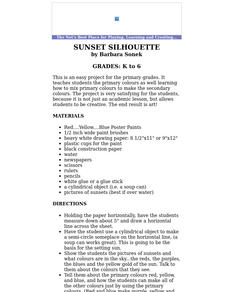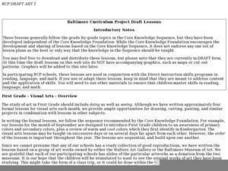Curated OER
Experimenting with Colors
Students experiment with mixing primary colors together using frosting and pretzel sticks.
Curated OER
Sunset Silhouette (primary colours)
Students draw and paint the sunset, learning about the primary colors while painting and mixing.
Curated OER
Exploring Colors
Learners research visual arts by reading a children's book. In this colors lesson, students identify the primary colors and utilize food coloring, plastic cups and eye droppers to create art using the color combinations. Learners read...
Curated OER
Easter Egg Eggstravaganza
Students identify functions and proper use of the computer. They identify secondary colors by mixing primary colors. Students reinforce listening, speaking and following directions by playing a game. They identify the color gold.
Curated OER
I Am Special, You Are Special Too #2
After being read a story, the students attempt to identify one individual difference, and one thing about themselves that is similar to other students in the class and one thing that makes them special. For the art lesson, students...
Curated OER
Mondrian, Math, and Amazing Colors
Students study geometric shapes, lines, and the primary colors as they create Mondrian-like art prints.
Curated OER
Visual Art: Primary Colors
First graders identify primary colors and consider their use in works by Henri Mattise and Mary Cassatt. They conduct an experiment with food coloring and then draw a color tree differentiating between warm and cool colors.
Curated OER
The Connection Between Pigment and Light Colors
Students learn the procedure for mixing secondary colors from primary pigments and observe the results of mixing two primary colors.
Curated OER
Design Motifs and Eggs
Pupils create an Easter egg that displays at least one secondary color, one primary color, and one motif of design.










